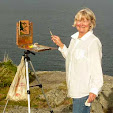negative space from the inside of the object out - if you start at the center of each object and work your way out, you can use painting the negative space (the space around the object) to shape each one. All the messiness of that first exuberant pass at the object, gets turned into greatness when you use the negative space to reshape it. I love the way this makes things look, like this slice of melon in front of another slice or the sky and tree.


blue and yellow don't make green - the use of two of each of the primaries, one leaning towards each other primary, is key to being able to mix any color you need, and the secret to making bright clear colors. Though I had already read the book by this name, it was Carol's approach that brought it home for me. I wouldn't have been able to make this green background color with the ultramarine blue that I was using as my only blue.

different strokes - Carol had us do an exercise where she said "each stroke has to be a different color, so mix something different for each one". For someone with a tendency to blend, like me, this was a revelation. I am still getting used to it.

Sorry for the length of this. It cements it for me to tell you about it. Thanks for listening!
There is already a waiting list for Carol's class in Freeport next August, but if you are interested, email Suzanne deLesseps.













